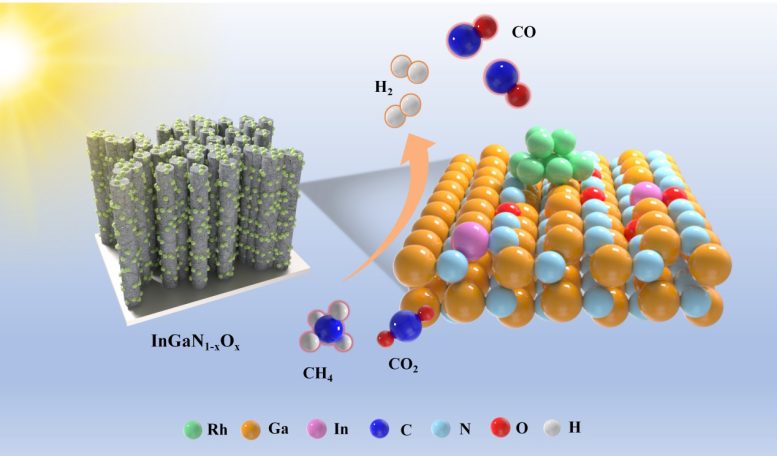An innovative photocatalyst, Rh/InGaN1-xOx, utilizing solar power to transform greenhouse gases into valuable chemicals, represents a significant leap in sustainable chemical production. This nanoarchitecture consists of rhodium nanoparticles on indium gallium nitride nanowires, which enhances the efficiency of methane dry reforming with CO2. Credit: SciTechDaily.com
A new photocatalyst developed by Shanghai Jiao Tong University offers a green, efficient method for converting greenhouse gases into chemicals using solar power, marking a significant advancement in sustainable chemical production.
The novel photocatalyst, named Rh/InGaN1-xOx, is a nanoarchitecture consisting of rhodium nanoparticles anchored on oxygen-modified indium gallium nitride nanowires grown on silicon substrates. Under concentrated solar illumination, this composite material demonstrates remarkable performance for the dry reforming of methane (DRM) with CO2, achieving a syngas evolution rate of 180.9 mmol gcat-1 h-1 with 96.3% selectivity. This represents a significant improvement over conventional catalytic systems, which often require high energy inputs and suffer from rapid deactivation.
“Our work represents a major step forward in addressing the dual challenges of greenhouse gas emissions and sustainable energy production,” said Prof. Baowen Zhou, the lead researcher from Shanghai Jiao Tong University. “By leveraging the power of solar energy and rationally designed nanoarchitecture, we have demonstrated a green and efficient route for converting waste gases into valuable chemical resources.”

Rh/InGaN1-xOx nanowires were explored for light-driven methane dry reforming with carbon dioxide towards syngas (CH4 + CO2 + light = 2CO + 2H2). It is proposed that the partial substitution of N in InGaN with O can greatly improve the activity and stability of the catalyst under light illumination without extra heating. Credit: Science China Press
Synergistic Effects and Mechanistic Insights
The researchers attribute the exceptional performance of their photocatalyst to the synergistic effects arising from the integration of the photo-active InGaN nanowires, oxygen-modified surface, and catalytically active rhodium nanoparticles. Mechanistic studies revealed that the incorporated oxygen atoms play a crucial role in promoting CO2 activation, facilitating CO generation, and suppressing catalyst deactivation via coking deposition.
The findings of this research, published in the prestigious journal Science Bulletin, pave the way for the development of advanced photocatalytic systems for the sustainable production of fuels and chemicals from renewable resources. The team believes that their approach can be extended to other important chemical reactions, offering new opportunities for greening the chemical industry.
“We are excited about the prospects of this technology,” said Prof. Baowen Zhou. “By further optimizing the catalyst design and reactor configuration, we aim to scale up the process and demonstrate its viability for practical applications.”
Reference: “Rh/InGaN1−xOx nanoarchitecture for light-driven methane reforming with carbon dioxide toward syngas” by Yixin Li, Jinglin Li, Tianqi Yu, Liang Qiu, Syed M. Najib Hasan, Lin Yao, Hu Pan, Shamsul Arafin, Sharif Md. Sadaf, Lei Zhu and Baowen Zhou, 12 February 2024, Science Bulletin.
DOI: 10.1016/j.scib.2024.02.020

Dr. Thomas Hughes is a UK-based scientist and science communicator who makes complex topics accessible to readers. His articles explore breakthroughs in various scientific disciplines, from space exploration to cutting-edge research.








